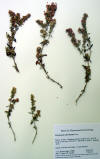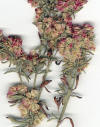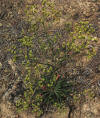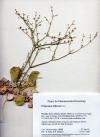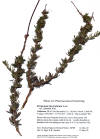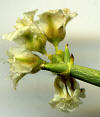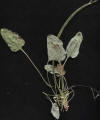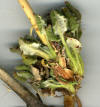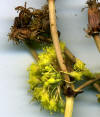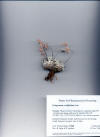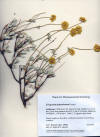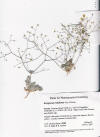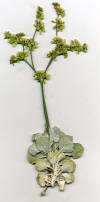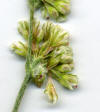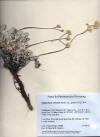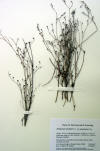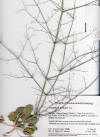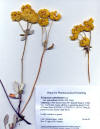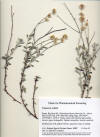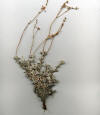|
Eriogonum abertianum
|
Eriogonum alatum New Mexico—Southern Rocky Mts. Arriba Co., Carson NF: ~50 miles east of Farmington, Mastena Mesa, north side of Hwy 64; 36º45'38.9", 107º12’09.8”, 2161 m. Pinyon-juniper-sagebrush woodland on alkaline soil. SPJ-16384, 23 July 2008 |
Eriogonum ampullaceum
|
|
Eriogonum baileyi California—Great Basin Desert. Mono Co., Humboldt-Toiyabe NF: North of Bridgeport along Hwy 395, rest area long river; 38º30'37.8", 119º26'59"4, 1680 m. Sandy stream margin with some rocks and willows in juniper-sagebrush zone, SPJ-16445, 26 Aug 2008
|
Eriogonum baileyi
|
Eriogonum brachypodum
|
 
Eriogonum breedlovei
|
Eriogonum brevicaule Colorado—Great Basin Desert. Moffat Co., Hwy 318, 16 miles northwest of Maybell, 1 mile on BLM Rd north of Hwy; 40º36'30.8", 108º20’18.1”, 1760 m. Gypsum and sand dunes, Pinyon-juniper woodland.
|
Eriogonum caespitosum
|
|
Eriogonum cernuum Utah—Great Basin Desert-Dixie Corridor. Washington Co., Red Mts., ~15 mi north of St. George on west side of Hwy 18; 37º18'31.2", 113º40.53.4", 1382 m. Sagebrush scrub with scattered juniper. Much-branched, foul-smelling (like cow manure) annual with a basal rosette of leaves and small taproot; flowers white. Locally abundant. Sample of entire plant (rt-st-lf-fl-fr). Richard Spjut & Paul Burchstead 16353, 21 June 2008.
|
Eriogonum corymbosum
|
Eriogonum
compositum
|
|
Eriogonum
compositum |
Eriogonum deflexum
|
Eriogonum deflexum
|
|
Eriogonum deflexum
|
Eriogonum deflexum
|
Eriogonum deserticola
|
|
Eriogonum elatum
|
Eriogonum fasciculatum
|
Eriogonum fasciculatum
var. foliolosum
|
|
Eriogonum fasciculatum
var. polifolium |
Eriogonum fasciculatum
var. polifolium
|
Eriogonum fasciculatum
|
|
Eriogonum heermannii
var. floccosum
|
Eriogonum heermannii
|
Eriogonum heracleoides Oregon. Blue Mountains. Wallowa NF, south of Lick Creek, elev. 6,000 ft., 29 July 2011
|
|
Eriogonum heermannii
|
Eriogonum jamesii New Mexico—Southern Rocky Mts. Arriba Co., Carson NF: ~50 miles east of Farmington, Mastena Mesa, north side of Hwy 64; 36º45'38.9", 107º12’09.8”, 2161 m. Pinyon-juniper-sagebrush woodland on alkaline soil. SPJ-16395A, 23 July 2008
|
Eriogonum latifolium
|
|
Eriogonum leptophyllum
|
Eriogonum nidularium
|
Eriogonum
nudum |
|
Eriogonum
nudum
|
Eriogonum
nudum
|
Eriogonum
nudum |
|
Eriogonum
nudum
|
South Fork of the Salmon River, CA, August 2006
|
Eriogonum ovalifolium Oregon. Steens Mt, Fish Lake Camp, Jackman Park and open sagebrush south and west; 42º43.838, 118º37.987, 7471 ft. Aspen forest-meadow communities. 9 Aug 2009. |
Eriogonum ovalifolium
|
Eriogonum ovalifolium
var. purpurascens
|
Eriogonum ovalifolium
|
|
Eriogonum ovalifolium
|
Eriogonum palmerianum
|
Eriogonum palmerianum
|
|
Eriogonum panamintense |
Eriogonum plumatella
|
Eriogonum pondii
|
|
Eriogonum prattenianum |
Eriogonum preclarum
|
Eriogonum pusillum
|
|
Eriogonum racemosum Colorado— Southern Rocky Mts. San Juan Mts., Archuleta Co., San Juan NF: between Durango and Pagosa Springs, Beaver Meadows Rd (FR 604), ~2 miles north off Hwy 160; 37º17'40.2", 107º29’32.6”, 2293 m. Ponderosa pine woodland with shrub understory of Quercus gambellii and Purshia tridentata. SPJ-16393, 22 July 2008
|
Eriogonum reniforme
|
Eriogonum rixfordii
|
|
Eriogonum roseum |
 
Eriogonum rotundifolium
|
Eriogonum saxatile
|
|
Eriogonum shockleyi Utah—Great Basin Desert-Bonneville Basin Region. Millard Co., Confusion Range, north side of Hwy 50, ~92 miles west of Delta; 39º04'42.7", 113º43.08.9", 1716 m. Limestone-sandstone outcrops in pinyon-juniper zone. Perennial in rounded clumps buried partly in sand over limestone; leaves involute, densely white hairy; flower heads yellow, sessile. Frequent Richard Spjut & Paul Burchstead 16361. 22 June 2008
|
Eriogonum sphaerocephalum
|
Eriogonum strictum
|
|
Eriogonum tenellum
|
Eriogonum trichopes
|
Eriogonum umbellatum
|
|
Eriogonum umbellatum
|
Eriogonum umbellatum |
|
|
Eriogonum
umbellatum
var. polyanthum |
Eriogonum umbellatum
|
Eriogonum
umbellatum
|
|
Eriogonum vimineum |
Eriogonum wrightii |
Eriogonum wrightii
|
|
Eriogonum wrightii
|
Eriogonum wrightii
|
Historical collection data on NCI-USDA plant
collections for cancer
research
|
|
Trees and Shrubs of Kern County (Jan 2013, May 2015) Eriogonum— often easily recognized at a glance by the flowers arising from within tiny cup-like to vase-like involucres arranged along various “aerial” flowering stems or scapes (inflorescences) arising at distal ends of “aerial stems”; each involucre may hold anywhere from 2 to 100 flowers. Each flower consists of 6 petal like lobes partially fused from the base to the mid region, generally referred to as “tepals”, or “perianth” or “calyx,” because technically petals are absent; however, in some species they can be differentiated by size, 3 outer and 3 inner; thus, the term tepals by Reveal (2005, FNA). The term scape is generally used in this treatment for species descriptions to include the aerial stems as well as the flowering stems. Scape technically is a leafless peduncle from a basal rosette of leaves, while few species of Eriogonum are described as having true flower scapes. The aerial stems may be undivided or highly branched like a tumble weed. Involucres may develop singly along a flowering stem or in clusters at ends of flower scapes arising from a stem base with a rosette of leaves. Fruits, which are achenes, generally are inconspicuous and not used in distinguishing species. Species of Eriogonum, which include numerous annuals, are encountered just about anywhere one travels in Kern County, or California, or in the western United States where there is plant life. While the genus Eriogonum is relatively easy to recognize, identifying the species is usually a challenge, because there are so many of them, ~250 in North America (Reveal 2005, FNA). However, a molecular study by Kempton (2012) suggests that some species in the genus may eventually be reclassified in other genera. In technical manuals, species are initially segregated by their floral characters of whether hairs are present on the tepals. To be able to confidently see hairs, scopes that magnify up to 30× can be helpful. The key below avoids many technical floral characters. Key to Eriogonum
1. Flower heads
(involucres) terminal on flowering scapes in umbrella-like
1. Involucres
developing along the axis of main stems or secondary branches
2. Bonsai-like matted
shrubs or subshrubs close to the ground, the leafy stems
2. Plants with tall
erect flowering stems, often 0.5–2 m high arising from
3. Flower scapes to 6
cm long with gland tipped hairs, simple to
Involucres not hairy or glandular, with round
teeth; peduncles obvious,
Involucres densely glandular, teeth
acute; peduncles generally concealed
3. Flower scapes 4–15
cm, not pedunculate, not glandular hairy; leaves 3a. Leaves of uniform width, 1–4 mm wide.......................................... var. pinicola 3a. Leaves wider in the mid to upper region........................................................... 3b 3b. Leaves 1.5–3.5 mm wide.......................................................... var. purpusii
3b. Leaves mostly <1.5 mm
wide......................................................................
3c 3c. Leaves 4–12 mm long....................................................... var. austromontanum 4. Leaves largely basal—in rosettes or clumps of rosettes................................................. 5
4. Leaves on branched
woody stems above base, in whorls or alternate
5.
Involucres on red
threadlike (filiform) stalks (peduncles); perennial
5. Involucres
supported directly by the floral stem; perennials often
6. Involucral bracts
~2× longer than wide, ribbed along center, or rib obscure,
6. Involucral bracts
(2.5-) 3–4× longer than wide, boat-shaped and keeled,
6a. Leaves not in a rosette flat to the ground, numerous and
crowded
6b. Upper leaf surface yellow green with
scattered tufts of short white hairs,
6b. Upper leaf surface gray green,
densely and continuously gray hairy;
6a. Leaves in a rosette, flat or nearly so to the ground, the
blades 6c. Leaves green on upper surface; plants herbaceous or subshrubs.................... 6d 6c. Leaves whitish to reddish or brownish above; plants herbaceous .................. 6f
6d. Aerial stems undivided for most of their length, turgid or
inflated;
6e. Plants not bushy at base,aerial
stems simple to sparingly
6f. Upper surface of leaves reddish to grayish green with
impressed
6f. Upper surface of leaves grayish green appearing to age
reddish
7. Leaves in whorls; flowers yellow..... ........................................... Eriogonum umbellatum 7a. Flowering stems dividing once into umbellate branches 7b. Leaves sparsely hairy below.......................................................... var. nevadense 7b. Leaves densely hairy below.......................................................... var. canifolium 7a. Flower stems with more than one set of umbellate branches...................................... 7c
7c. Leaves lacking hairs on both surfaces; local in Sierra
Nevada 7c. Leave hairy........................................................................................................... 7d 7d. Leaves densely white hairy on both surfaces; ...................................... var. bahiiforme
7d. Leaves hairy more underneath than above, or hairs in tufts
7e. Leaf surfaces with hairs in tufts (floccose), or
floccose below . 7e. Leaves densely hairy below, floccose above...................................................... 7f
7f. Flower stems uniformly covered with wavy hairs; low mats,
7f. Flower stems sparingly floccose, or without hairs;
shrubs
7g. Subshrubs, wider than tall, to 60 cm high and 80 cm broad;
7g. Shrubs to 1 m high and broad; possibly Eastern Sierra Nevada 7. Leaves in alternate clusters below flower scapes; flowers white to rose................................... 8
8. Rays of umbel with leaf-like bracts at base....................................... Eriogonum fasciculatum
Rays of umbels ascending, relatively long in flower heads 8. Leaves or leaf-like bracts lacking at base of umbels......................... Eriogonum microthecum Flowering stems tan to reddish brown hairy............................................ var. corymbosoides Flowering stems white hairy......................................................................... var. laxiflorum
9. Aerial stems
collectively a round mass of densely short zigzag floral 9. Aerial stems with a well-defined main axis. ........... ................................................................ 10
10. Flower heads erect
along horizontal side branchlets of main erect
10. Flower heads
developing along a main erect stem in singles or
11. Leaves in tight
basal clusters, erect, blade spoon-shaped, 1–2× longer than
11. Leaves not strictly
basal, blades generally elliptical, 2–3× longer than
12. Plants mostly tall
leafless herbaceous stems,
12. Low densely
branched leafy stemmed plants < 60 cm
Bonsai-like matted shrubs or subshrubs close to the Erect shrubs, taller than wide; leaves 1.5–3 cm long...................................... var. trachygonum
Shrubs wider than tall but not cushion forming, much like
Eriogonum breedlovei (E. ochrocephalum S. Watson 1880 var. breedlovei J. T. Howell 1963) Reveal 1966 var. breedlovei. Matted shrub with branched woody stem and crowded leaves, to 10 cm high and 20 cm across; leaves erect in terminal clusters, with broad elliptical blades nearly as long as petioles, 2–8 mm long, pale green above with whitish hairs, more densely white hairy below, margins plane or narrowly and tightly rolled under; flower scapes to 6 cm, densely glandular; peduncles 0–2 mm; flowers Jun–Sep, white. Limestone and dolomite ("quartzite" JM2, FNA type locality) outcrops along ridges in mixed conifer woodlands (white fir, Jeffrey pine), 2,300–2,500 m; endemic to Kern Co., Owens Peak and Piute Mts. Type from Piute Mountains, ridge between Liebel Peak and Piute Peak, 6.9 miles northwest of Claraville on Saddle Springs-Claraville Road, 7,900 ft. Eriogonum breedlovei var. shevockii J. T. Howell 1976. Differs from the preceding by the flower scapes lying down, and shortly branched peduncles; granite outcrops in conifer woodlands, 2,300–2,800 m; Kern and Tulare Cos. Kern Co. Type from east end of The Needles, Tulare Co., California. Reported from the Kern Plateau (The Needles, Cannell Peak, Baker Point, Little Kern River Gorge), Owens Peak, White Dome, Bartolas Country, Eriogonum elatum Douglas ex Bentham 1836 var. elatum. Tall Eriogonum. Plants woody and leafy at base with tall erect trichotomously branched flower scapes, to 1.5 m; leaves erect, broadly arrow-shaped, abruptly tapered near base to a narrow decurrent portion along the petiole 5-25 cm in length, nearly as long as the blade, 4-15 (-25) cm long, with scattered to dense cover of white wavy hairs on both surfaces and along margins, veins raised on lower surface; flowers May–Oct; flowers white; involucres 1 per node, or 2-5 clustered. Sand and gravel flats or slopes, sagebrush steppe, pinyon juniper and conifer woodlands, below 10,000 ft; Idaho to Washington, south to California and Nevada where more spotty with notable isolated occurrences in Lloyd Meadows in Tulare Co. and on the Kern Plateau in Kern Co (Reveal 2005, FNA), “east of Fay Canyon” (Twisselmann). Type: “Abundant between the Great Falls and Grand Rapids of the Columbia,” Oregon or Washington. No records in CCH from Kern Co. Eriogonum elongatum Bentham 1844 var. elongatum. Long-stemmed Eriogonum. Plants appearing bushy by the many conspicuous tall and wand-like flexuous flower scapes, these occasionally branching dichotomously, often with longer undivided stems, to 2 m; stems arising from woody taproots, often persisting for more than one season; leaves developing at base and above the base, fasciculate or appearing in whorls, erect with petioles shorter than blades, the petioles 5–20 mm, the blades 1–3 (-5) cm long, narrowly elliptical to slightly wider above or below the mid region, gradually tapered and shortly decurrent to petiole; dense white cottony below, thinner above, veins obscure, wavy indented along margins; flowers any month but mostly Jul–Nov, white in ball-like clusters scattered along a flowering stem; involucres 1 per node, long hairy. Sandy or loam flats or slopes in coastal sage and chaparral, oak and conifer woodlands below 6,000 ft; California to northwestern Baja California. Type from Hills above San Pedro, Los Angeles Co., California. Kern Co.: Occasional, sometime locally common in the Upper Sonoran associations from the Temblor Range southeast to the hills at the west end of Antelope Valley in the Gorman region” (Twisselmann), 963–1,302 m (CCH). Two other varieties in Baja California. Eriogonum fasciculatum (Bentham 1836) var. foliolosum (E. rosmarinifolium Nuttall var. foliolosum Nuttall 1848) S. Stokes ex Abrams 1910. Leafy California buckwheat. Differs from var. polifolium (below) in the longer branches of the main flower scapes arising in an umbel-like arrangement. Native to central and southern California, planted along roads in other areas, including the desert, and spreading naturally. Type from Santa Barbara, CA. Kern Co.: “Common in the northern Temblor Range where it occasionally reaches Kern County in the Annette region” (Twisselmann), 305–1,188 m (CCH). Eriogonum fasciculatum var. polifolium (E. polifolium Bentham 1856) Torrey & A. Gray 1870. Mojave Desert California buckwheat. Rounded subshrub, with numerous partly woody reddish stems from a thick branched woody base, generally 0.5–1.0 m high; leaves in alternating clusters, narrowly elliptical, usually from 3–5× as long as wide, curved downwards across the upper green surface and more strongly along margins, densely white cottony beneath except along the green midrib and recurved margins; flowers any time of the year, usually from Apr–Nov, in shortly branched heads at the ends of long flowering scapes, which persist after the flowers are gone; flowers white to pale rose, turning dark red in fruit. Common on rocky desert and chaparral slopes in southern California, to Utah, northwestern Arizona and Mexico. Type from near Oak Creek Pass, Tehachapi Mountains, Kern Co. California buckwheat scrub recognized in MCV2 when >5% absolute cover in the shrub canopy. Kern Co.: “Often densely covering arid slopes at the lower elevations of the Temblor Range and along the desert facing slopes,” and in the desert Rand and El Paso Mts. (Twisselmann), 200–2,134 m (CCH). This variety was shown in Kempton (2012) to be nested within the herbaceous genus Chorizanthe. Eriogonum heermannii Durand & Hilgard 1857 var. heermannii. Heermann's wild buckwheat. Densely branched shrubs to nearly 2 m high and broad, the branches very fine; leaves alternate, short, broad elliptical, 2–3× longer than wide, white hairy on both surfaces, greener above, rolled under along margins; flowers Jul–Sep, yellowish white in scattered involucres on much-branched flowering stems that hardly differ from branchlets. On gravelly substrates, 3,000–5,000 ft; southern Sierra Nevada (Kern Co., Tehachapi Mts.), southeastern Coast Ranges (southeastern San Luis Obispo Co.), northern Transverse Ranges. Type from Pose Creek, which is probably Walker Pass according to Twisselmann. Hermann’s buckwheat patches provisionally recognized in MCV2. Kern Co.: “Rare,” “usually in small colonies on rocky slopes in the pinyon woodland from Walker Pass southwest to Cuddy Valley” (Twisselmann); also Short Canyon, San Emigdio Range (Bitter Creek Natl. Wildlife Refuge, Pleito Hills), Tehachapi Mts. near Tejon, and north of Phillips Rd. Neuralia; 823–1,579 m (CCH). Eriogonum inflatum Torrey & Fremont 1845. Desert trumpet. Perennial with a woody root, occasionally flowering the first year, thus appearing annual, or the annual form distinguished by grayish stems in contrast to bluish-green (glaucous) stems commonly seen in perennial plants; leaves in a basal rosette with petioles much longer than the blades; blades generally round, heart shaped to kidney shaped, often with a round shallow notch at base; upper surface green with impressed veins, lower surface green; flowering any month; flower stems erect, trichotomously branched; involucres 1–1.5 mm long on strict capillary peduncles 0.5–3 cm in length; flowers pale yellow with greenish to red midribs, densely curvy haired, 1–4 mm. Widely distributed in western North America below 6,000 ft; roadsides, ditch margins, sand washes, rocky slopes and flats in various desert brush and woodland communities; Colorado to Sonora, west to California and Baja California. Type from along the Mojave River," probably collected at Bitter Springs, west of Baker, San Bernardino Co., California. Kern Co.: “Common in the rock places from the desert southwest to Mt. Pinos” (Twisselmann), 579–1,585 m (CCH). Although E. inflatum has been generally recognized by the inflated flowering stems, Reveal (2005, FNA) described the stems as “occasionally fistulose.” The inflated condition is reportedly the result of a build-up of carbon dioxide in the stems as the leaves wilt during moist spring conditions, while inflation is reportedly less in plants that develop during dry conditions (Reveal 2005, FNA, citing specific studies). The var. deflatum I.M. Johnston, which has been recognized in the past, and the only variety to occur in Baja California (Wiggins 1980), was listed as synonym by Reveal (2005, FNA). Inflated stems are also seen in other species such as the annual E. trichopes, and subshrub varieties of E. nudum, which are distinguished by the absence of peduncles; the inflated stems in E. nudum vars. auriculatum, indictum, and westonii are given more taxonomic weight than in E. inflatum. Eriogonum kennedyi Porter ex S. Watson 1877 var. kennedyi. Kennedy's buckwheat. Low mound (Twisselmann, Fig. 51), or bonsai-like shrub, <15 cm high, stems woody, shortly branched and terminally densely leafy; leaves thick, very short (< 5 mm) 1–2× as long as wide, curled (appearing subterete), densely clustered and woolly; flowering Apr–Jul; flowers in terminal involucral heads on leafless thin flowering scapes above the leafy plant, 5–15 cm. Gravelly substrates on Mt. Pinos and San Bernardino Mts, 5,000–9,000 ft. Type: “In the Sierra Nevada, Kern Co.,” “probably from the lower slopes of Mt. Pinos, Ventura Co., California, just S of the Kern Co. line” (Reveal). Kern Co.: “A main ground cover over an extensive area on the “summit plateau of Mt. Pinos” (Twisselmann, Fig. 50. who recognized only E. kennedyi var. austromontanum), reported also along the Pacific Crest Trail in the southern Sierra Nevada north of Cameron, and just south of there in the Tehachapi Mountains, southern end of the high ridge south of Purdy [Purdie] Canyon, Tejon Ranch and in Frazier Mountain (CCH). Additionally, the species was not clearly differentiated from E. wrightii in a molecular phylogeny study of Polygonaceae (Kempton (2012). Eriogonum kennedyi var. austromontanum Munz & I. M. Johnston 1924. Distingiushed from the typical variety by the sparse hairs on the flower stems and by the larger involucres, 2.5–4 mm. Known only from the San Bernardino Mountains around Bear Lake and Baldwin Lake, not in Kern County. Eriogonum kennedyi var. pinicola Reveal 1968. Kern buckwheat. Differs from the preceding in the flat leaves and flowering later (May–Jun). Type from Sweetwater Ridge, south of Cache Peak, Kern Co., California. Kern Co.: Gravel slopes south of Cache Peak, 5,400–6,200 ft. Four to six populations with an estimated 10,000 plants found on white clay soils of pebble plains in association with associated with Layia glandulosa, Mimulus androsaceous, Calochortus kennedyi and Allium cratericolam, and with Jeffrey pine and single-leaf pinyon pine at the edge (A. Sanders, CDFG, 1998; CNPS: List 1B, R-E-D Code 3-3-3, Skinner and Pavlik, 1994). Eriogonum kennedyi var. purpusii (Eriogonum purpusi Brandgee 1899) Reveal 1968. Purpus wild buckwheat. Distingiushed from the typical variety by the white hairs on the leaves. Flowers May–Jul. Esmeralda Co., NV and S Mono Co. to Inyokern in Kern Co. Type from California, gravelly places, 4,000 to 5,000 ft. Kern Co.: Eastern Sierra Nevada: Indian Wells Canyon, Inyokern; Sand Canyon south of Sugarloaf Mountain, ~7 airmiles northeast of Tehachapi’ (Hare 4 Nov 1995, JEPS-CCH). Back Canyon ridge on saddle overlooking Caliente Creek, Indian Creek, and Cottonwood Creek along Cache Peak segment of Pacific Crest Trail southern end of Sierra Nevada Range ~12 air-miles northeast of Tehachapi (Hare 6 Jun 1996, JEPS-CCH); Piute Mountain, 1650 m, Onkar Singh 3 Jun 2010 (UCR- CCH), An “excellent rock-garden plant” and also used in “dried decorations” (Reveal 2005). Eriogonum microthecum Nuttall 1848 var. corymbosoides Reveal 1971. San Bernardino wild buckwheat. Differs from var. laxiflorum (below) by having reddish hairs instead of white hairs. Eastern slopes of San Bernardino Mts., on gravel; 3,300–6000 ft. Type from Johnston Grade, 0.8 mi below summit NE of Baldwin Lake, San Bernardino Mountains, San Bernardino Co., California. Kern Co.: Tehachapi Mountains, Cache Creek, ~7 miles northwest of Mojave along Hwy 58, 1.25 miles east of junction of Hwy 58 and Cameron Rd., Tehachapi Pass, 1,200 m (Ballmer, 2 Sep 1998, CCH) , and Oak Creek Canyon, just southwest of existing wind turbine facility, 1,524 m (S. White & J. Wood, 3 Jun 2009, CCH) . Eriogonum microthecum var. laxiflorum Hooker 1853. Great Basin wild buckwheat. Subshrub with ascending hairy stems and hairy leaves < 0.5 m high; leaves short with parallel margins, tapering to apex, 2–3× longer than wide, 1–2 cm long, gray-green above with white hairs, densely white cottony beneath; flowers Jun–Oct, in terminal involucral heads from short branched scapes above leaves, white to pink or rose. Common on sand, gravel or rocks, eastern slopes of southern Sierra Nevada and Great Basin Desert, to Washington, Montana, Colorado and northern Arizona. Type from “Rocky Mountains of the Columbia in Oregon," probably NE Oregon.” Collected by Twisselmann from the divide between Kelso Valley and Jawbone Canyon, and by Shevock from 8 km south of Lake Isabella on slopes of Laura Peak in Piute Mountains, in the Erskine Creek drainage - Kings River Basin. Referred to as var. panamintensis Stokes in Moe. Eriogonum nudum Douglas ex Bentham 1836 var. nudum. Perennial from a small taproot, not woody, with flower stems to 1 m high; leaves basal, flat with the ground, blades round in outline, or slightly longer than wide on petioles longer than the blades; flowering Jun–Sep; flower stems dichotomously branched, ultimately trichotomous with a shorter central branch with terminal cluster of 2–5 involucres; flowers white rarely yellow. Generally described by Reveal (2005, FNA) to occur from Washing to California below 7,000 ft, “mainly in the Coast Ranges and interior valley” on “sandy to gravelly flats, slopes, banks, and washes, mixed grassland and chaparral communities, oak and conifer woodlands.” “At higher elevations in the Sierra Nevada” “ it is replaced by var. deductum”, which may be distinguished by longer leaves, (1-) 2–5 cm. Type from Plains of the Multoonah [=Multnomah]," or along the Willamette River, Clackamas Co., Oregon. Recognized by Twisselmann as “common in the Temblor Range, especially in the Upper Sonoran grassland; occasional, south to the Mt. Pinos region and in the foothills of the Greenhorn Range.” However, JM2 and the CCH records indicate that the typical variety does not occur in Kern County, mainly shown to occur in the northern Coast Ranges and Sierra Nevada as far south as Tulare County [update—June 2015, 5 records from Kern Co. Greenhorn Mts., 1 mi E of Kern Co. Park; Glennville, trail to Sunday Peak; Chuckwalla Canyon, Chuckwalla Mt.; Tejon Ranch, Lecheria Canyon]. Eriogonum nudum var. auriculatum (E. auriculatum Bentham 1836) J. P. Tracy ex Jepson 1914 [E. latifolium Smith 1809 ssp. auriculatum S. Stokes 1936]. Nude buckwheat. Subshrub from a long thick woody taproot, branching above ground with leaves clustered at base and flowering stems to 2 m; basal leaves erect with petioles about equal to blades in length; blades broadly arrow-shaped, or widest below mid region and rounded to base, tapering slightly to a round apex, ~3× longer than wide, 3–7 cm long, 2–4 cm wide, green above, whitish densely hairy below; crinkled (“undulate-crisped”) along margins, occasional smaller leaves at nodes of first flower branches. Flowering Jul–Oct; flowering scapes dichotomous, or with an involucre between two ascending branches, usually with 2–5 involucres clustered terminally on the branches, occasionally inflated; involucres with 2 or 3 green scale-like bracts at base, mostly green; flowers cream to pink or rarely yellowish. Coastal strand, chaparral, Valley; Coast Ranges from Sonoma Co. to Monterey Co. Type from near San Francisco [exact location uncertain], California. Kern Co.: “Rare in rocky places and in shale banks in the northern Temblor Range, reaching its southern limits in Cedar Canyon” (Twisselmann). Records in CCH also from Kern River Canyon (R. Hoffmann, 11 Apr 1930) and Tejon State Park (Moe, 9 Jul 2001). Eriogonum nudum var. deductum (Greene 1902) Jepson 1914. Similar to var. nudum, distinguished by the longer leaf blades, 1–5 cm, as apposed to leaves 1–2 cm. Reported in Kern Co. from east side of Sunday Peak, 7,450 ft, occasional in granitic sand in a rather barren area on an east slope in a mixed conifer forest (Twisselmann 3854, CCH: CAS594808). According to Reveal (2005): “Variety deductum is the common mid-elevation tetraploid expression of the species, found primarily in the Sierra Nevada, including some desert ranges just to the east. It is not always readily distinguished from var. nudum. At higher elevations, var. deductum is replaced by var. scapigerum.” Eriogonum nudum var. indictum (E. indictum Jepson 1914) Reveal 1968 [E. latifolium Smith 1809 var. indictum (Jepson) S. Stokes 1936]. Subshrub from a long thick woody taproot, branching above ground, or forming a round woody base near ground with leaves clustered at base or along branched shoots above base and with numerous flowering stems to 1.8 m, conspicuously and gradually inflated upwards to the nodes; basal leaves spreading to erect with petioles slightly longer than blades in length; blades broadly arrow-shaped, abruptly tapered to petiole, tapering slightly to a round apex, 1–2× longer than wide, 1–6 cm long, 1–3 cm wide, densely white hairy on both surfaces, or less so on upper surface, with impressed veins on upper surface; crinkled (“undulate-crisped”) along margins. Flowering May–Oct; flowering scapes dichotomous, unequally so on ultimate shorter branches, usually with 1 involucre per node; involucres with 3 reddish scale-like bracts at base; involucral bracts boat-shaped; flowers cream to pink or yellow. Woodlands below 3,600 ft; mostly along the Inner Coast Ranges south of Bay Area to Transverse Ranges with an apparent disjunct occurrences in Kern Co. Type from Rancho Cantua at Lillis Ranch on Cantua Creek, San Carlos Range, Fresno Co., California. Kern Co.: “Occasional in barren places or on cuts, slides, etc. in the Temblor Range south to Maricopa. A large colony of exceptionally robust plants grows in barren asphaltic soil just west of McKittrick” (Twisselmann); also on lower slopes of Breckenridge Mt.; and one record from Weldon 365–388 m (CCH). Eriogonum nudum var. pauciflorum S. Watson 1877. Perennial herbs or subshrub, with numerous aerial stems to 2.0 m; basal leaves mostly flat to the ground, blades heart-shaped, abruptly tapered to petiole, tapering slightly to a round apex, 1–2× longer than wide, 1.5–3 cm long, 0.8–1.8 cm wide, densely hairy below, bald above, with impressed veins on upper surface inconspicuous; margins plane. Flowering Jun–Oct; aerial stems dichotomous, unequally so on ultimate flowering stems, usually with 1 involucre per node; involucres bracts slightly boat-shaped and keeled; flowers white or rarely pale yellow. Chaparral, woodlands and sagebrush communities, 3,600–9,000 ft, Transverse Ranges south to Baja California. Type from head of Pine Creek [location unknown], San Bernardino Mountains, Los Angeles or San Bernardino counties, California. Kern Co.: “Common around rocky places in the red fir forest on Sunday Peak (Twisselmann), also Owens Peak Trail, Red Rock Canyon, San Emigdio Range Mt. Pinos, Tehachapi Mts. Cummings Valley, Caliente Wash, Rattlesnake Grade Rd, Oak Flat Peak, 305–2,500 m (CCH). Eriogonum nudum var. pubiflorum Bentham 1856. Described as perennial to 1 m with flowering stems to 30 cm; however, reported by Reveal (2005, FNA) to be difficult to distinguish from var. auriculatum in the Coast Range of Central California, thus, subshrub forms may be expected in Kern Co. Leaves in the typical form on petioles slightly longer than the round to kidney-shaped or heart shaped blades, <1.5× longer than wide, 1–4 cm, more hairy below than above, or upper surface bald, veins impressed, margins plane; flowers Jun–Oct, white or “infrequently” yellow; aerial stems dichotomous, upper flower branches dichotomous or with an involucre in the axil of forking branches; involucres 2–7 per cluster, the bracts boat shaped, yellowish and white along the edges with reddish tips. Regarded as common throughout its ranges in California, northwestern Nevada and southern Oregon, sandy to gravel often volcanic flats and slopes in various shrub communities, and also oak and conifer woodlands, below 7,000 ft. Type form northeastern California or south-central Oregon, without specific location. Kern Co.: “Common in the mountains at the middle elevations south to Mt. Pinos and Brush Mountain; occasional to the Jeffrey pine forest, rare from the rocky desert-facing canyons to the creosote bush association” (Twisselmann). CCH: Tehachapi Pass, Jawbone Canyon, 5 miles southwest of Mojave, Breckenridge Mt., Bodfish, Kern River Canyon near Power House east of canyon mouth, Oak Flat Peak in Greenhorn Mts., Shirley Meadows, 1.5 miles west of Sherman Grade, Weldon, 305–2,591 m. CCH specimen collected from the Temblor Range in San Luis Obispo Co. by Short & Johnson (27 Apr 1934) was identified by Reveal as var. pubiflorum in 1974, and reidentified by him in 1997 as var. westonii. As Reveal pointed out in other studies, his concept var. pubiflorum became more restricted, and that of var. westonii broadened, which also included his var. gramineum (Reveal 2005, FNA). It may be further noted that the type of E. saxicola at HUH was identified by Reveal as var. pubiflorum in 1967, which would then correspond to the understanding of the taxon by Twisselmann under the name E. latifolia ssp. saxicola. Although E. saxicola is currently regarded as a synonym of var. westonii, Moe’s assignment of var. saxicola in Twisselmann to var. pubiflorum is correct; var. pubiflorum had been considered a synonym of ssp. saxicola in Munz. Two Kern County records in CCH from RSA, however, cite E. nudum ssp. saxicola, one from Pine Mountain Club (D. Charlton, Apr 1991), the other from north of Mt. Tehachapi (Gustafson, July 1981). Eriogonum nudum var. regirivum Reveal & J. Stebbins 1989. Plants perennial from a woody rhizome or root, to 1.8 m high; leaves basal sheathing slightly up the stem but not at nodes, the blade broad elliptic, <1.5× longer than wide, 2.5–3.5 cm long, usually on longer petioles, (2-) 4–6 (-7) cm, densely white hairy below, grayish hairy, or hairs wearing off, then appearing reddish underneath, or with scattered tufts of hairs above, margins slightly crisped; flowering Aug–Nov; flower stems erect, slender, hairy, or hairs appears to wear off in spots, 10–30 (-40) cm long; flower scapes strict, 0.33–1.0 (-1.4) m long; bracts scale-like, ternate, linear to triangular, mostly 1–3 (-5) mm long, densely hairy except at tip, basally connate; involucre clusters 3–6 per head, short boat-shaped, 3–4 mm long, white hairy; flowers creamy white, 1.5–3 mm long, densely. Oak and pine woodlands on limestone slopes700–2,000 ft. Type from Fresno Co., 0.75 mi east of road's end, Kings River Canyon, Sierra National Forest, T12S, R27E, NW/4S26, 487 m. Generally not known outside Fresno County. Calphotos includes an image of a specimen collected along Kings River, 1600 ft by James Shevock (26 May 1988). The specimen shows more densely hairy leaves on upper surface and also the stems; however, the keys in Reveal (2005) and JM2 suggest exceptions in which the variety may not be hairy (glabrous) and then has to be distinguished by leaves “sheathing up the stem.” Kern Co. East slopes of the Greenhorn Mountains, Old State Road, transition between mixed conifer forest and montane chaparral, based on a single observation and a single plant with developing inflorescence (area burned. June 2014 fire). Variety pubiflorum has similar leaves, but differs in the leaf veins appearing more conspicuous, or by the annual or short-lived perennial habit (images of specimens in the Consortium of the Pacific Northwest Herbaria accessed June 2015, in the online Intermountain Flora Herbarium) and by generally occurring outside arid regions (Reveal 2005, key), except perhaps in Kern County (Twisselmann). Variety pauciflorum, which has similarly shaped leaves, differs by the green leaf color, and more densely branched aerials stems. Variety indictum occurs west of the Sierra Nevada, and var. auriculatum is distinguished by the longer arrow-shaped leaves. Although the southern occurrence may be questionable, other disjunct occurrences of northern plants are found nearby such as Actaea rubra, Cornus nuttallii, Garrya fremontii, and Rubus parviflorus. Eriogonum nudum var. westonii (E. latifolium Smith 1809 ssp. westoni S. Stokes 1936) J. T. Howell 1976 [Includes E. nudum ssp. saxicola (E. saxicola A. Heller 1906) Munz 1974; E. latifolium Smith 1809 ssp. saxicola S. Stokes 1936; E. gramineum S. Stokes 1936; E. nudum var. gramineum (S. Stokes 1936) Reveal 1985]. Subshrub from a branched woody root-stem complex with clumps leaf rosettes clustered at base and with numerous flowering hollow stems to 2.0 m; basal leaves flat to the ground with petioles to 10× longer than blades, the blades heart-shaped or round and broadly tapered to petiole, tapering slightly to a round or bluntly pointed apex, 1–1.5× longer than wide, 1–3 cm long, 0.3–0.8 cm wide, green on both surfaces, the undersurface with a low dense cover of interwoven white wavy hairs and with scattered tufts of taller white hairs (floccose), upper surface mostly floccose, veins obscure on upper surface, slightly wavy along margins. Flowering May–Sep; flowering scapes undivided for most of their length, then shortly sub-umbellate, the branches unequal, followed by very short branches or 1–3 clusters of involucres with reddish scale-like bracts at base; involucral bracts boat-shaped, white drying brown, boat-shaped and keeled, 3–4× longer than wide; flowers usually yellow or “infrequently” white. Southern part of the eastern Sierra Nevada and Panamint Mts. to Greenhorn Range, Piute Mts., Tehachapi Mts., Red Rock Canyon, Mt Pinos, San Gabriel Mts. Type from the Greenhorn Mts [actually from the "Tehachapi Pass road," Tehachapi Range (Reveal Univ. MD website). Reveal (2005, FNA) indicated that eastern Sierra Nevada plants with one or few prominently inflated stems may be referred to var. gramineum. Eriogonum plumatella Durand & Hilgard 1855. Flat-topped buckwheat. Plants strikingly distinct for their long erect aerial stems crowded together, each with alternating short horizontal branches, ultimately bending horizontally, for which its common is given, to 1.5 m high; aerial stems densely white hairy and leafy; leaves dark green, heart-shaped on petioles shorter than heart-shaped blades with long white interwoven hairs; flowers (Apr) Aug–Nov, white. Desert washes near mountain slopes below 5,500 ft, largely along the western edges of the Mojave and Sonoran deserts, and southern fringe of the Mojave Desert, California, Northwestern Arizona and southern Nevada. Type reported from Pose Creek, CA, but probably Walker Pass region fide Twisselmann. Kern Co.: “Occasional, desert-facing slopes of the mountains south to the Tehachapi Mountains and east to Red Rock Canyon” (Twisselmann), also Long Canyon (Keeler-Wolf 1990). CCH records from Walker Pass, 10 miles south of Mohave, Short Canyon, Piute Mountains along Kelso Valley Rd, 854–1,463 m. Eriogonum saxatile S. Watson 1877. Rock buckwheat. Perennial from a woody taproot and shortly branched stems, loosely to densely matted, to 20 cm, much like some species of Dudleya, densely white- or grayish-hairy. Stems often with persistent leaf bases; aerial flowering stems developing on upper half, slender, solid, 5–15 cm. Leaves basal, or in fascicles at ends of basal branches; leaves near base blade spoon shaped to round, 1–2.5 cm on petioles 1–3(-4) cm, upper leaves without petiole, blade elliptic to round, 0.3–1 cm. Flowering stems dichotomous; bracts 3–4, scale-like and triangular, 1.5-7 mm. Involucres 1 per node, 3–4 mm, loosely hairy. Flowers May–Aug, white to rose or yellowish, 5–7 mm, including the elongate, triangular and winged stipe-like base; with dimorphic tepals. Decomposed granite or volcanic rocks on flats, slopes, and ridges; chaparral, saltbush, and sagebrush communities, pinyon-juniper and montane conifer woodlands; 1,000–11,000 ft; South Coast Ranges, Southern Sierra Nevada and western Nevada, to San Bernardino Co, and western Nevada (Esmeralda and western Nye counties). Type from Mill Creek Canyon, San Bernardino Mountains, San Bernardino Co., California. Kern Co.: “Occasional to scarce in rocky places from the Douglas oak and pinyon woodlands to the yellow pine forest in the Sierra Nevada north of Walker Pass, in the Greenhorn Range” (Twisselmann), 731–2,195 m. Eriogonum umbellatum Torrey 1827. Sulphur flower. A common shrub in California and elsewhere, generally identified by the umbellate arrangement of flowering scapes with terminal heads of sulphur yellow flowers that appear during July. Type from "Base of the Rocky Mountains," probably near Manitou, El Paso Co., Colorado. Twisselmann recognized one variety; Moe six varieties. Two additional varieties reported in the flora. Eriogonum umbellatum var. bahiiforme (E. polyanthum Bentham var. bahiiforme Torrey & A. Gray 1870) Jepson 1914. Bay buckwheat. Low leafy shrub, spreading along ground in a mat to 60 cm across, the leafy stems to15 cm high. Leaves elliptical or widest above the region, tapering abruptly or gradually to apex, 1–2× longer than wide, 5–15 mm, densely white hairy. Flowers Jul–Sep, in terminal involucral heads on whitish hairy scape, yellow. On serpentine, 700–2,000 m. JM2 indicates this variety to occur along the Inner Coast Ranges. Type from Mount San Carlos near New Idria, San Benito Co., California. Kern Co. San Emigdio Range: near Valle Vista Public Camp on Mt Abel Rd, and from Lookout Point, Piute Mts., 1,447–2,520 m. Twisselmann gives other locations but as noted above he only recognized this one variety in Kern Co. Eriogonum umbellatum var. canifolium Reveal 2004. Sherman Pass sulphur flower. Described as mats 3–10 dm in diam. and to 20 cm high; leaves in tight rosettes; flowers bright yellow . Sandy soil, 2400–2600 m., southern Sierra Nevada (Inyo, Tulare cos.), Desert Mts. (Argus Range). Type from Sierra Nevada, Sherman Pass Road, 0.4 mi above junction of Rattlesnake and Woodpecker trails, 3.5 mi E of Paloma Meadows and 9.2 mi E of Sherman Pass, N36º01ʹ40ʺ, W118º16ʹ35ʺ, T.22S, R34E, sec.11 NE1/4 of the SW¼, 8400 ft elev., Tulare Co., California. Kern Co.: San Emigdio Range on Mt. Abel Rd., 9.6 miles south of Grocer Grade Summit, 4,950 ft.; Mount Pinos region, Head of Cuddy Valley; steep E slope facing N branch of Seymour Creek towards Mt Pinos Campground, 7,500 ft (CCH). Eriogonum umbellatum var. chlorothamnus Reveal 1968. Sherwin pass buckwheat. Described as a subshrub or shrub, 5–10 dm, 5–12 dm diam; flowers Jul-Sep, bright yellow. Type from Summit of Sherwin Grade, 4 mi S of Tom's Place, Mono Co., California. On sandy substrates, 1600–2600 (-2,900) m; southern Sierra Nevada and nearby high desert to northwestern Mojave Desert. In Moe; no records in CCH for Kern County. Eriogonum umbellatum var. ellipticum (E. ellipticum Nuttall 1848) Reveal 1983 [E. umbellatum var. stellatum (Bentham) M. E. Jones]. CCH has two specimens assigned to this variety: one from HSC collected by C. W. Tilforth & John Dourley (23 Sep 1975) W of Lake of the Woods along Cuddy Valley Road (Mt Pinos Route) towards Mt. Pinos, 2,165 m and the other at RSA collected by Twisselmann (19 Aug 1958) from the summit of Breckenridge Mountain, 2,300 m. Reveal (2005, FNA) indicated that this variety does not occur in California; it is found in Montana, Idaho, Washington, and Oregon. The HSC Tilforth & Dourley specimen is also identified as var. subaridum at RSA. Eriogonum umbellatum var. furcosum Reveal 1985. Sierra Nevada sulphur flower. Described as a subshrub 3–6 dm high and, 3–8 dm in diam; flowers Jun-Sep, bright yellow. Common on sand or gravel, 1,200–3,000 m. Sierra Nevada to western central Nevada. Type from El Dorado Co., along Calif. Hwy. 89, 2.2 mi S of US Hwy 50 on sandy granitic soil, associated with Arctostaphylos, Artemisia, and juniper-pinyon. Kern Co.: ~ 2 1/4 mi northeast of Greenhorn Summit Store near Cow Creek —Greenhorn Mts.; Kings River Basin, Spanish Needle; Tehachapi Mountains; between Bodfish and French meadows near the North-Piute road, 1,615–2,072 m (CCH). Eriogonum umbellatum var. munzii Reveal 1970. Munz's sulphur flower. Described as a mat 3–6 dm in diam and 1–2 dm high; flowers Jun-Sep, bright yellow. Sand or gravel, 1,500–2,600 m. Transverse Ranges, San Jacinto Mts. Type from Baldwin Lake, San Bernardino Mountains, San Bernardino Co., California. Kern Co.: Walker Pass, St Hwy 178; San Emigdio Range, Mount Pinos; ~ 1/4 mi southwest of entry to County Park off Mil Portero Highway 2 miles west of Frazier Pk., Lockwood Valley Road, 1,585–2,362 m (CCH). Eriogonum umbellatum var. nevadense Gandoger 1906. Nevada sulphur flower. Described as a subshrub 1–5 dm, 2–6 dm diam; flowers Jun-Sep, bright yellow. Common on sand or gravel, 1,500–3,000 m. east slopes of the Sierra Nevada, Great Basin Desert, northwestern Mojave Desert, to southeastern Oregon and western Nevada. Type from Huffakers, near Reno, Washoe Co., Nevada. Kern Co.: rock outcrop with Pinus jeffreyi, ridge between Liebel Peak and Piute Peak; 6.9 mi. northwest of Claraville on Saddle Springs-Claraville Rd, 2,409 m (CCH). Eriogonum umbellatum var. polyanthum (E. polyanthum Bentham 1856) M. E. Jones 1903. American River sulphur flower. Described as a shrub 4–10 dm, 5–10 dm diam.; leaves 1–3 cm, 0.3–1.3 cm wide, light green with or without thin hairs below; flowers Jun–Sep; flowers bright yellow. Rocks, 800–1500 m; northern Sierra Nevada and Cascade region. Indicated in JM2 not to have been collected in the past 100 years. Upper Sacramento River Valley, possibly near the American River, Plumas Co., California. CCH includes two specimens collected by Twisselmann under var. polyanthum from Lookout Point, Piute Mts., 30 Aug 1963 and 16 Sep 1964, apparently identified Twisselmann who indicated in his flora under var. bahiiforme that this variety intergrades the var. polyanthum, and he treated the specimens under var. bahiiforme . Reveal (2005, FNA) stated that the name polyanthum has been misapplied in California to plants he attributed to vars. modocense and dumosum; both occur in northern California, and further north. The geographical occurrence for the variety are mostly along the eastern Sierra Nevada as far south as Tulare Co., becoming more widely distributed across the montane region in northern California (CCH). Eriogonum umbellatum var. subaridum S. Stokes 1937. Ferris' sulphur flower. Described as a subshrub or shrub, 2–7 dm, 3–9(12) dm diam. Common on sand or gravel; 1,200–3,100 m; flowers Jun-Oct, bright yellow. Southeastern Sierra Nevada, Transverse Ranges, desert mountains to southwestern Colorado and northern Arizona. Type from Kyle Canyon, Spring Mountains, Clark Co., Nevada. Kern Co.: Mt Pinos region west of Lake of the Woods along Cuddy Valley Road (Mt Pinos Route), towards Mt. Pinos; Owens Peak, east side of summit following ridge; Ridgeline above Buena Vista Canyon; summit of Morris Peak; Piute Creek road 2.55 mi from Caliente Creek-Walker Basin road; Scodie Mountains, Kiavah Wilderness area; Horse Canyon-Cane Canyon Saddle; Mts. Pacific Crest Trail, on the east side of Mount Jenkins; Temblor Mountains region, Mt. Pinos, road junction, Frazier Mt. Park, San Joaquin Valley Drainage (4,300 ft), 1,311–2,470 m. Eriogonum wrightii Torrey ex Bentham 1856 ssp. wrightii. Mostly desert mountains in southern Mojave Desert to Chihuahua Desert in Texas and adjacent northern Mexico. CCH includes two specimens assigned to this variety, one from Kernville and the other from Mt. Abel. Another specimen from Kernville—by a different collector—was annotated by Reveal as var. trachygonum. Other specimens from Mt. Abel not annotated by Reveal have been identified var. subscaposum. The nearest collections var. wrightii to Kern Co. on the CalFlora website appear to be from the Kingston Range and north base of the San Bernardino Mts. Eriogonum wrightii ssp. subscaposum S. Watson 1880. Short-stemmed bastard-sage. Shrub with low bonsai rounded habit, or in loose mats close to the ground, <30 cm high, to 50 cm across; leaves 5–12 mm long; flowers appearing Jun–Sep; in scattered clusters along a long flower scapes, white with rose veins. Common on gravel or rocks, Southern Coast Ranges, Sierra Nevada, Transverse Ranges, eastern Peninsular Ranges, 5,000–10,500 ft. Type from Scandinavian Canyon, Silver Mountain, near Silver City, Alpine Co., California. “ Wright’s buckwheat patches recognized when >50% relative cover in the shrub canopy. Kern Co.: “Common, mostly along exposed ridge tops but also in the pinyon woodland, in the Pinos region at the summit of Breckenridge Mountain, in the Piute Mountains, and on Black Mountain in the Greenhorn Range, and on the Kern Plateau” (Twisselmann), 915–2,990 m (CCH). Eriogonum wrightii ssp. trachygonum Jepson 1901. Rough-node bastard-sage. Plants generally larger than preceding, 20–40 cm high, and with shorter leaves, 1.5–3 cm; flowers Jul–Oct. Common on “[g]ravel to rocky flats and slopes, mixed grassland and chaparral communities, oak and conifer woodlands” (Reveal in FNA), below 3,000 ft. In JM2 indicated to occur in the northwestern ranges, southern Cascade Region, northern Sierra Nevada. Type from “Valley of the Upper Sacramento,” probably Shasta Co., California (Reveal). Kern Co.: “Common, mostly in the arid shrub association and pinyon woodland but also frequent in the Douglas oak woodland and chaparral in the southern Sierra Nevada and Piute Mountains south to the head of Caliente Canyon and Walker Basin, 731–2,287 m (CCH). Reveal in FNA indicated that the distinction between this and the preceding variety is imprecise.
Abdel-Kader, M.S. and F. R. Stermitz. 1996. Cytotoxic phenolic glucosides from flowers of Eriogonum brevicaule. Planta Med. 62(4): 383. “In collaboration with Utah State University, the protein actin was identified as that which crosslinks to DNA via a pyrrolizidine alkaloid metabolite.”
|
||
